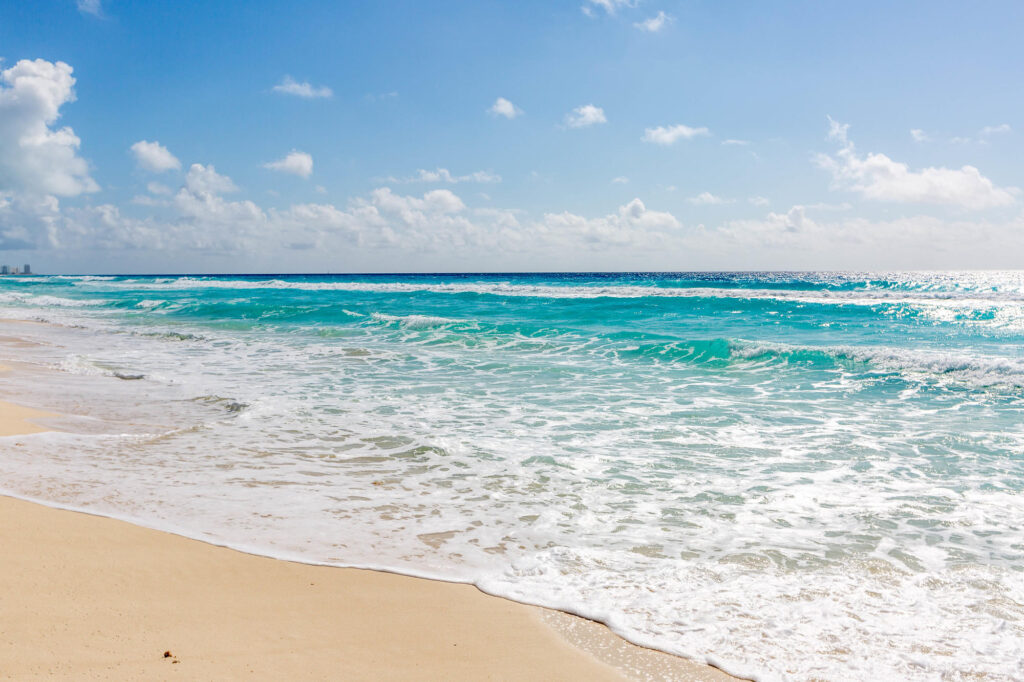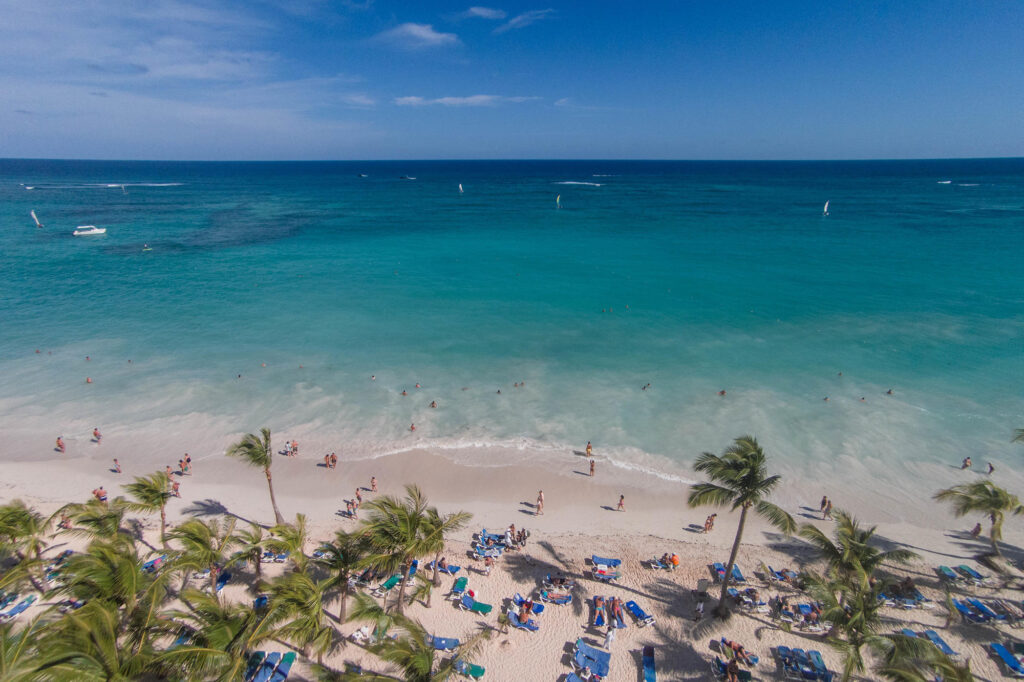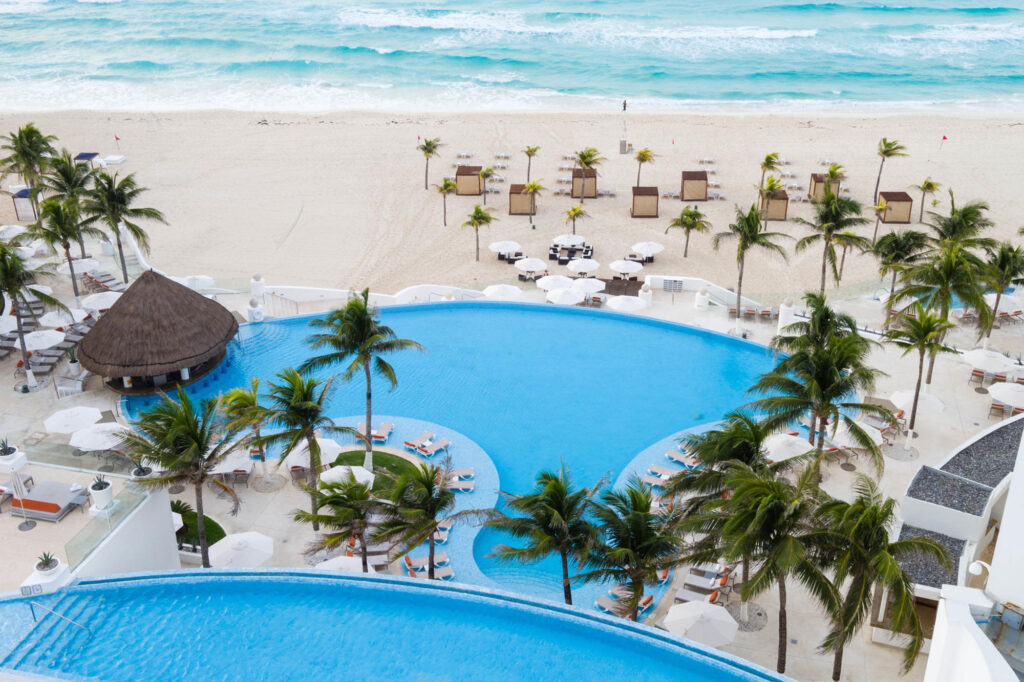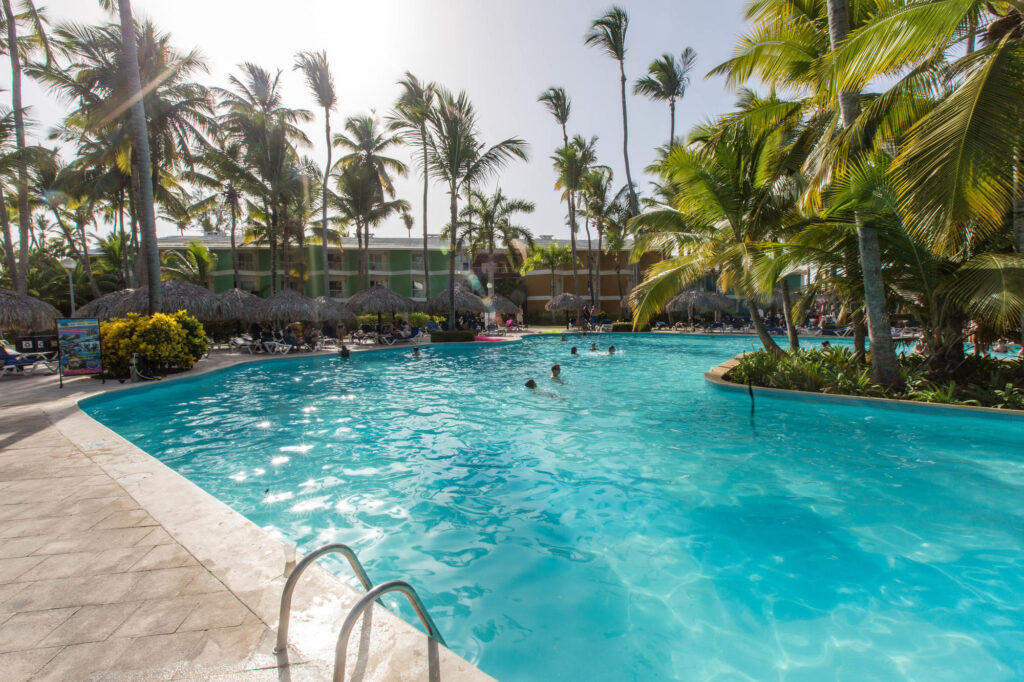Additional reporting by Megan Johnson
If there were a popularity contest for sunny vacation spots offering a seemingly endless number of all-inclusive resorts, Cancún in Mexico and Punta Cana in the Dominican Republic would undoubtedly fall at the top of the list. Straddling either side of Cuba — about 1,200 miles apart — both destinations boast gorgeous white-sand beaches, year-round tropical weather, and many of the same hotel chain brands. But with so many similarities, how do they compare to one another? We’ve matched these major tourist players off in a handful of categories, starting with how to get there from the airport. Check out our head-to-head and discover which makes for a better vacation spot for you.
Cancún vs. Punta Cana at a Glance
| Criteria | Cancún | Punta Cana |
| Price | Generally more expensive | Generally less expensive |
| Beaches | Beautiful white sand beaches with clear turquoise water | Beautiful white sand beaches with clear turquoise water, some choppier areas |
| Hotels | Wide range of hotels, from budget-friendly to luxury | Mostly all-inclusive resorts |
| Getting There | Easier to get to from the US and Canada | Flights might be slightly more expensive than Cancún |
| Dining and Nightlife | More diverse dining options, including local restaurants, a vibrant nightlife scene | Mostly all-inclusive dining; limited nightlife outside of resorts |
| Safety | Exercise increased caution; safety concerns in some areas | Exercise increased caution; safety concerns in some areas |
| Honeymoon Travel | Good for couples who want to combine relaxation with cultural experiences and nightlife | Ideal for couples seeking a relaxing and secluded getaway |
| Family Travel | Offers a variety of activities for families, including water sports and Mayan ruins | More limited options for family activities outside of the resort |
| Adults-Only Travel | Many adults-only resorts are available | Some adults-only resorts available |
Traveling to Cancún and Punta Cana

Cancún
Cancún is located on the Yucatan Peninsula, facing the Caribbean Sea. Hence, its geographical position makes it an easy jaunt for those living in the Midwest and East Coast of the U.S. Many airlines like Delta, JetBlue, Air Transat, Frontier, and American Airlines also make non-stop flights — especially during spring break. Those arriving from Canada and the U.S. must present a current passport plus a visitor’s permit, known as the FMM, provided at the entry point. No visa is necessary, but checking the government website for any updates before booking a trip is best. The Hotel Zone is about a 20-minute drive from the airport and can be reached by bus, a shared shuttle that makes stops between resorts (expect to pay a small price), or a private taxi that can cost between $50 and $60. As for getting around, the local bus system is perfect for adventurous types, but some choose to rent a car to have the freedom to explore. Plus, English-speaking visitors will be pleased to find that they can get by with limited Spanish, as Cancún locals are used to meeting travelers from their northern neighbors.
Punta Cana
Punta Cana is located along the Caribbean Sea and Atlantic Ocean on the Dominican Republic’s easternmost tip. Flights from the U.S. and Canada are slightly more expensive than flights to Cancún. Remember that Punta Cana International Airport was the first privately owned international airport in the world (owned by Frank Rainieri), and it receives about six million arrivals per year. At the customs and immigration desk, each visitor will receive a 30-day tourist card in exchange for $10 USD. That being said, you will need to have cash on arrival. Some resorts within Puntacana Village, like the Four Points by Sheraton, offer complimentary shuttle service and are close to the airport. Others are a private taxi ride away. Some, like Excellence Punta Cana, take nearly an hour to reach from the airport and can cost upwards of $70. Shared shuttle services are also provided, but folks may encounter language barriers while arranging these on the spot if it’s not part of a tour package.
Winner: Cancún
Beaches in Cancún and Punta Cana
Cancún
When it comes to beaches and scenery, both locations will not disappoint. Situated at Yucatan’s corner, where the Caribbean Sea meets the Gulf of Mexico, Cancún boasts warm, clear, turquoise water — the kind people fantasize about when planning a tropical vacation. The Hotel Zone’s coastline offers plenty of white sand and pleasant water, allowing for water sports, sunbathing, swimming, and long walks along the shore. The sand will likely also be maintained (i.e., seaweed-free), and you’ll probably be close to a bar and bathroom. The best snorkeling in the Hotel Zone can be found towards the southern end. Rowdy groups of spring breakers tend to stick to the pools (and the pool bars).
Punta Cana
Much like Cancún, Punta Cana, which is filled with white sand, coconut palms, crystal-clear waters, and lush coral reefs, offers ample opportunities to kayak, windsurf, snorkel, and enjoy other non-motorized sports, depending on the all-inclusive resort. If seaweed debris accumulates overnight, many resorts have rakers clear it up in the morning to maintain the pristine setting. However, the coastline varies depending on the location — some areas of the sea are more choppy than others, and some resorts have a narrow strip of sand that can feel crowded. These latter resorts also tend to have a morning rush for reserving one of the slightly worn plastic chairs. Other properties, like the Iberostar Grand Bavaro Hotel, have large, secluded swaths of crowd-free sand dotted with shaded palapas. Packed with sun-seekers, partiers, and the like, Bavaro Beach is the most famed of the Punta Cana area beaches. Soft white sand, towering palm trees, and endless ocean vistas all clamor for attention, though remember that the surf here is rougher than you’ll find on the D.R.’s Caribbean side.
Winner: Cancún
Culture and Activities in Cancún and Punta Cana
Cancún
Cancún, part of the ancient Mayan civilization, is considered the gateway to El Mundo Maya (the Mayan World), so plenty of day-trip options can be arranged with tour groups. Popular day trips include Isla Mujeres (located eight miles off the coast), Cozumel (a one-hour drive plus a ferry ride away), and the sacred Chichen Itza (situated two hours west). There’s also a small set of Mayan buildings in downtown Cancún. Cancún has much better shopping options with upscale malls like La Isla and Luxury Avenue. Two hours south of Cancún is the trendy Tulum, where centuries-old temples are built along the shore. The Caribbean Sea offers coral reefs for snorkeling and scuba diving, including the island of Cozumel and Cenotes, a big sinkhole filled with freshwater and fish. Kids can play with spider monkeys at The Jungle Place Sanctuary. For more inspiration on what to do in and around the area, check out our stories on the best excursions in Cancún as well as the most unexpected day trips from Cancún.
Punta Cana
Punta Cana doesn’t have a historic town center or ancient ruins, so for the most part, visitors choose to stay at their resort. Many are here to take advantage of the beaches, spas, water sports, and alcohol and are perfectly content not leaving the property. Those itching to break free can head out on a Santo Domingo sightseeing tour, sign up for a surfing lesson, take a catamaran cruise to Saona Island, or arrange horseback riding, zip-lining, and snorkeling tours. For more ideas on what to do in and around the area, check out our story on the best excursions in Punta Cana.
Winner: Cancún
Dining and Nightlife in Cancún and Punta Cana
Cancún
Cancún and Punta Cana both primarily consist of all-inclusive environments. In Cancún, many all-inclusive resorts include breakfast and lunch buffets, so most local restaurants serve lunch starting around 2 p.m. and keep their doors open until midnight for dinner. For those who like to venture out, several types of cuisine can be found in and around the Hotel Zone, but there are only a few oceanfront restaurants. Instead, those who want their meals with a side of a stunning view can dine at the waterfront restaurants facing Nichupte Lagoon, which also serves up beautiful sunsets. Downtown Cancún is a taxi ride away and presents a range of Mexican restaurants, fresh seafood, and international cuisine types. And when it comes to the nightlife, many might picture folks chugging beers, foam parties, and wet t-shirt contests — after all, this is and has been a popular spring break destination. If the thought of this makes you cringe, perhaps it’s wise to skip visiting the destination during March and April. The party hot spots do get steady crowds all year long, though, pulling in ages from 18 (legal drinking age in Mexico) to mid-50s and up. Plus, nightclubs tend to sell open-bar bracelets, which allow you to pay one price to enter and drink all night; bottle service is also sometimes encouraged. Cancún also offers bar hopping tours, which hit several nightclubs in one night. For a full list of the best nightlife venues, check out our story on the best clubs and bars in Cancún, in which we highlight spots like Coco Bongo, Mandala, Senor Frogs, and much more.
Punta Cana
As previously mentioned, Punta Cana is a destination where most visitors will stay at their all-inclusive resort — and that goes for all meals, too. Many resorts here offer several different buffet options for breakfast and lunch and several a la carte options for dinner (reservations are typically required through guest services). Remember that food and drink quality varies, so check out our thorough hotel reviews before booking. High-quality resorts like Paradisus Punta Cana offer extensive international buffet spreads and are likely to impress even the most discerning all-inclusive resort-goers. Some a la carte restaurants, like Paradisus Palma Real Golf & Spa Resort, may have a dress code. The romantic Passion restaurant here also boasts a menu designed by a celebrity chef from Spain. Some resorts even offer an upgraded VIP option with more choices. As for nightlife, pre- and post-dinner cocktails can be enjoyed at bars sprinkled around the resort. Entertainment in the form of music and dance occurs nightly (think lip-synched Michael Jackson performances). Late-night discos, like the one at Occidental Caribe, are also common.
Winner: Cancún
Safety in Punta Cana and Cancún
Cancún
Is Cancún safe? Quintana Roo, which includes Cancún, has a Level 2 warning from the U.S. Department of State. This means travelers should exercise increased caution. The warning states that “While most of these homicides appeared to be targeted, criminal organization assassinations and turf battles between criminal groups have resulted in violent crime in areas frequented by U.S. citizens.” (To put things in perspective, other countries with a Level 2 warning include Italy, Germany, and the United Kingdom.) That said, as long as tourists stick to popular areas and keep their wits about them, as with any location, Cancún feels extremely safe.
Punta Cana
Much like Cancún, the Dominican Republic also has a Level 2 warning from the U.S. State Department. The website states: “Crime is a threat throughout the Dominican Republic though tourist destinations are generally more heavily policed and safer than other metropolitan areas.” For more information, check out our story on safety in the Dominican Republic.
Winner: Tie
History and Hotels in Cancún and Punta Cana
Cancún
Cancún’s growth began to explode in the late 1960s when the Mexican government realized the city’s potential and revealed its plans for tourism development. The Hotel Zone (with over 100 hotels, where most people stay) is a lengthy 14-mile strip of sand shaped like the number seven. It features a lagoon on one side and the sea on the other. Prices here tend to be mid-range, though you won’t be hard-pressed to find everything from cheap hostels, like the Hostal Mayapan, to pricey luxury resorts, like Le Blanc Spa Resort.
Punta Cana
Punta Cana was nothing more than a few sparsely populated fishing villages (without access to roads) until five American investors saw its potential and purchased the 30-square-mile land in 1969. They partnered with a local businessman, Frank Rainieri, and traveled to France to woo Club Med into opening Punta Cana’s first resort in 1978. The international airport opened in 1984, and since then, Punta Cana has introduced more than 100 all-inclusive resorts. The Grand Palladium, for example, is just one of four resorts inside a 2,000-plus-room mega-resort complex. It’s spacious, but a shuttle bus connects all the properties. Resort prices here also tend to be cheaper than in Cancún. Plus, the properties attract more diversity from charter tour groups from Canada, Russia, Italy, France, Germany, and Scandinavia. This gives Punta Cana an international vibe, unlike Cancún, which can feel more American. Those seeking a more intimate boutique property can stay at Tortuga Bay, a 30-room hotel designed by Oscar de la Renta and offers amazing service, including preferential treatment at the Punta Cana International Airport.
Winner: Punta Cana
Bottom Line
While Cancún seems to “win” in each category, both destinations are fantastic for a tropical getaway, especially if you’re on the market for an adult, all-inclusive beach spot. The most significant factor may come down to availability: flights, hotels, and pricing. Do your research to see the cost of flights and hotels in both places. It may come down to the fact that you like the look of one hotel in either spot. If pricing and timing of flights are the same, then it comes down to this: if you’re looking for an all-inclusive destination allowing some day trips off the resort, pick Cancún. If you simply want to stay at the resort your entire stay and aren’t interested in cultural experiences off-site, pick Punta Cana.
Our Top Pick for a Cancún Hotel: Le Blanc Spa Resort
The luxurious, 260-room Le Blanc Spa Resort is the best (and priciest) adult-only all-inclusive in town. It stands out for its gorgeous white-sand beach in the heart of the Hotel Zone, decadent spa (guests get free access to the hydrotherapy area), stunning pools (two with swim-up bars), and especially its pampering service from the butlers who will unpack your clothes to the pool attendants who will provide cool towels for your eyes. It has a hip, gorgeous aesthetic throughout the entire pristine white property, and the modern, bright rooms have two-person whirlpool tubs; most have either ocean or lagoon views.
Our Top Pick for a Punta Cana Hotel: Grand Palladium Punta Cana Resort & Spa
The oldest of the four resorts that make up the 2,000-plus-room Grand Palladium mega-resort in Bavaro, the upscale, 537-room Palladium Punta Cana is also the most affordable. It attracts an active and party-friendly crowd of younger, primarily North American adults. Every room has an oversized jetted tub, and the main draws are the clean white-sand beach, access to four free-form pools, and eight reservation-free restaurants.
You Might Also Like:
• Are All-Inclusive Resorts Worth The Money?• Enter for a Chance to Win an All-Inclusive Sandals St. Lucia Stay
• 9 of the Best Bang for Your-Buck All-Inclusive Resorts in the Caribbean
• How to Be the Worst All-Inclusive Resort Guest Ever
• Sicily or Sardinia? Find Your Ideal Italian Island Adventure
All products are independently selected by our writers and editors. If you buy something through our links, Oyster may earn an affiliate commission.








